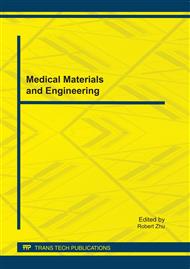[1]
IARC. IARC Special Report: Policy. A Review of Human Carcinogens-Part C: Metals, Arsenic, Dusts, and Fibres. Lyon: IARC Press, 2009, pp.453-454.
Google Scholar
[2]
M.F. Hughes. Biomarkers of Exposure: A Case Study with Inorganic Arsenic. Environ Health Perspect, 114(2006) 1790-1796.
Google Scholar
[3]
C.G. Yuan, X.F. Lu, N. Oro, Z.W. Wang, Y.J. Xia, T.J. Wade, et al. Arsenic Speciation Analysis in Human Saliva. Clin Chem ,54 (2008) 163-171.
DOI: 10.1373/clinchem.2007.092189
Google Scholar
[4]
B. Fängström, S. Moore, B. Nermell, L. Kuenstl, W. Goessler, M. Grander, et al. Breast-feeding Protects against Arsenic Exposure in Bangladeshi Infants. Environ Health Perspect, 116 (2008) 963-969.
DOI: 10.1289/ehp.11094
Google Scholar
[5]
Ministry of Health. Diagnosis Standards on Arsenicosis of China. Beijing:Ministry of Health of the People's Republic of China, 2001.
Google Scholar
[6]
World Medical Association. 1989. Declaration of Helsinki. Available: http://www. wma.net/e/ policy/pdf/ 17c.pdf [accessed 30 March 2006].
Google Scholar
[7]
G.F. Sun. Arsenic contamination and arsenicosis in China.Toxicol Appl Pharmacol, 198(2004) 268-271.
Google Scholar
[8]
G.Q. Yu, Z. CHen, L.J. Zhao and D.J. Sun. The analysis of epidemic trends of endemic arsenicsis in China. Chin J Endemiol, 29 (2010) 3-8.
Google Scholar
[9]
Ministry of Health. Standards for Drinking Water Quality. GB5749-2006. Beijing:Ministry of Health of the People's Republic of China, 2006.
Google Scholar
[10]
Z. Li, S.X. Wang, Z.H. Wang, T. Wang, X.Y. Qiao, X.D. Zhang, et al. Arsenic levels in external environment in endemic arsenism area of Shanxi province. Chin J Ctrl Endem Dis, 23 (2008) 270-271.
Google Scholar
[11]
Z. Li, S.X. Wang, Z.H. Wang, T. Wang, X.Y. Qiao, X.D. Zhang, et al. The relationship between arsenic in drinking water and skin lesions in endemic arsenism area in Shanyin County of Shanxi Province. Chin J Endemiol, 28 (2009) 88-90.
Google Scholar
[12]
G.F. Sun, Y.Y. Xu, X. Li, Y.P. Jin, B. Li and D.J. Sun. Urinary Arsenic Metabolites in Children and Adults Exposed to Arsenic in Drinking Water in Inner Mongolia, China. Environ Health Perspect, 115 (2007) 648-652.
DOI: 10.1289/ehp.9271
Google Scholar
[13]
D.P. Lima, D.G. Diniz, S.A.S. Moimaz, D.H. Sumida and A.C. Okamoto. Saliva: reflection of the body. Int J Infect Dis, 14 (2010) 184-188.
Google Scholar
[14]
G.R.C. Almeida, C.F. Freitas Tavares, A.M. Souzaet, T.S. Sousa, C.A.R. Fal, F.B. Jr, et al. Lead in saliva from lead-exposed and unexposed children. Sci Total Environ, 407 (2009) 1547-1550.
DOI: 10.1016/j.scitotenv.2008.10.058
Google Scholar
[15]
M.C. Talio, M.O. Luconi, A.N. Masi and L.P. Fernadez. Cadmium monitoring in saliva and urine as indicator of smoking addiction. Sci Total Environ, 408 (2010) 3125-3132.
DOI: 10.1016/j.scitotenv.2010.03.052
Google Scholar
[16]
H. Fakour, A. Esmaili-Sari and F. Zayeri. Scalp hair and saliva as biomarkers in determination of mercury levels in Iranian women: Amalgam as a determinant of exposure. J Hazard Mater, 177 (2010) 109-113.
DOI: 10.1016/j.jhazmat.2009.12.002
Google Scholar
[17]
K. Lew, C.G. Yuan, J.P. Acker and X.C. Le. Salivary arsenic as a biomarker for arsenic exposure.Cell Biol Toxicol, 24 (2008) 367-371.
Google Scholar


